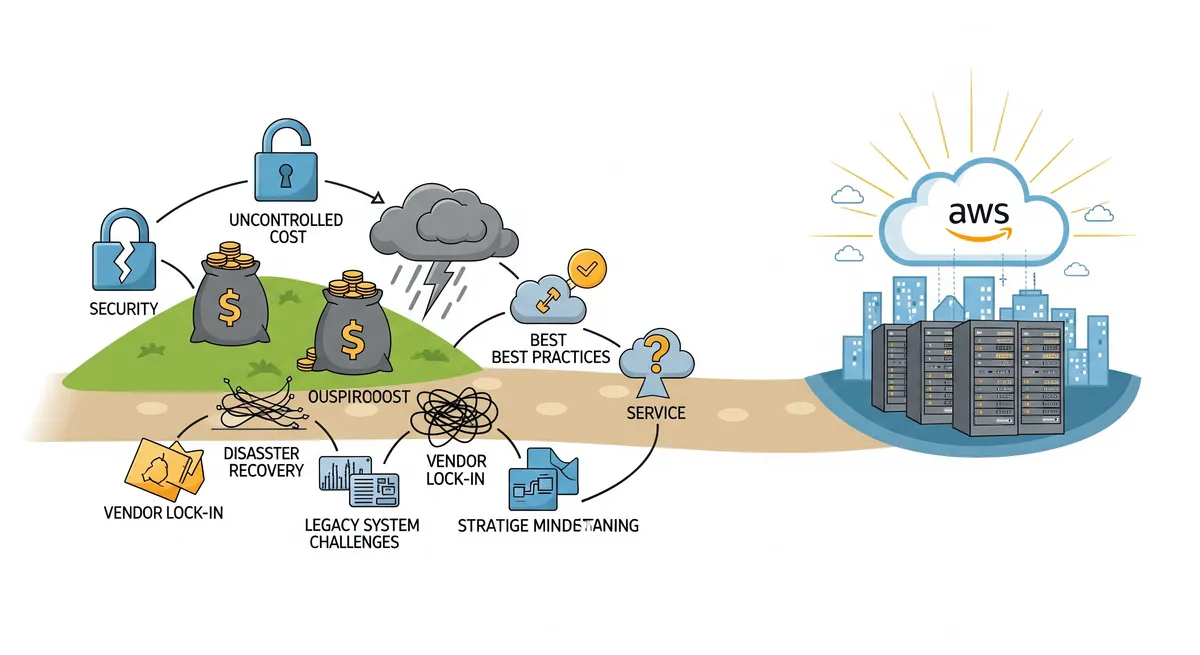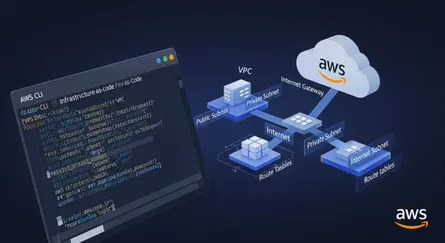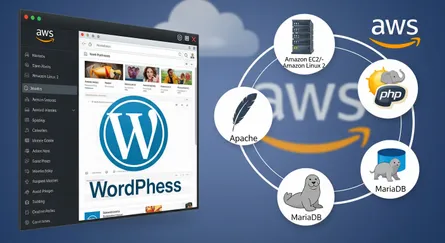Introduction
By offering scalable, on-demand resources and services, cloud services have completely changed the way organizations operate. Implementing cloud services, however, can provide its own set of difficulties and possible blunders. Common errors including inadequate resource security, a lack of understanding of the service, and the absence of a disaster recovery strategy can result in expensive downtime, security breaches, and even data loss.
Amazon Web Services is one of the most well-known suppliers of cloud services (AWS). Numerous services, including computing power, storage, databases, analytics, and more, are offered by AWS. While there are numerous advantages to using AWS, it’s critical for organizations to be informed of any potential drawbacks before using these services. For instance, improper S3 bucket security on AWS might result in sensitive data being made available to the public, as was the case in a number of high-profile events in the past. Additionally, the organization may incur unanticipated high expenditures as a result of failing to monitor and manage resource utilization.
With a particular focus on Amazon Web Services, we will examine some of the most frequent mistakes made while establishing cloud services and provide solutions for avoiding them in this article (AWS). Businesses may guarantee a seamless and safe installation of cloud services while also reaping the numerous benefits they provide by taking the time to understand and avoid these pitfalls.
Common fatal mistakes at Cloud Services
When implementing cloud services, businesses often make mistakes that can have severe consequences. The following are some of the most common mistakes made when implementing cloud services and how to avoid them.
- Before implementation, businesses could not completely comprehend the capabilities and constraints of the service they are installing, which can result in worse performance, higher costs, and unanticipated downtime.
- Failure to effectively protect cloud resources can result in data breaches and unauthorized access. Examples of such cloud resources include virtual machines, storage, and databases.
- Monitoring and regulating resource utilization is important since failing to do so might result in unexpectedly significant expenditures for the company.
- In the case of an outage or disaster, not having a disaster recovery strategy in place might lead to data loss and protracted downtime.
- Businesses may find it difficult to migrate data and applications across cloud providers, which would result in a loss of control and higher costs if vendor lock-in and loss of control were taken into account.
- If compliance requirements are not taken into consideration, businesses may not be aware of the compliance standards that apply to their sector, which might result in non-compliance and significant legal problems.
For example, with AWS, improper S3 bucket security can result in sensitive data being made available to the public, as was the case in a number of high-profile events in the past. Furthermore, failing to monitor and manage AWS resource utilization might result in unexpectedly large expenditures for the company. In the case of an outage or disaster, not having a disaster recovery strategy on place in AWS can lead to data loss and protracted downtime. It can be challenging to migrate data and apps across cloud providers due to vendor lock-in and loss of control with AWS.
Businesses should be aware of these typical errors and take the appropriate precautions to avoid them. Businesses may guarantee a seamless and safe installation of cloud services while also reaping the numerous benefits they provide by taking the time to understand and avoid these pitfalls.
Not fully understanding the service before implementation
Not knowing a cloud service completely before to installation is one of the most frequent errors enterprises make. It may also result in unanticipated downtime, higher expenses, and worse performance. Prior to use, it’s crucial to thoroughly investigate and comprehend the service’s capabilities and constraints.
For example, with AWS, a lack of scalability and availability might result from a failure to properly comprehend the capabilities and restrictions of Amazon Elastic Compute Cloud (EC2). Additionally, failing to properly comprehend Amazon Simple Storage Service’s (S3) capabilities and constraints might result in unexpectedly expensive costs for data storage and retrieval.
Businesses should investigate and comprehend the service they intend to use, including its capabilities, limits, and cost, in order to avoid making this error. All of AWS’s services are covered by documentation and tutorials, and companies may use the free-tier service to test the product before committing to a complete deployment. Businesses may also seek the assistance of AWS-certified experts who have the expertise and knowledge to help them fully comprehend the service and its potential.
In order to prevent unforeseen problems and expenses, it is crucial for organizations to take the time to understand the service they intend to deploy. Businesses may guarantee a seamless and effective installation of cloud services by properly knowing the service.
Failing to properly secure cloud resources
Implementing cloud services without properly securing cloud resources is another error that enterprises make frequently. Insufficiently protecting cloud resources like virtual machines, storage, and databases can result in data breaches and unauthorized access.
Businesses should take the required actions to adequately protect their cloud resources in order to avoid making this error. This includes the following in AWS:
- Enabling encryption for data at rest and in transit
- Using Identity and Access Management (IAM) to control access to resources
- Using security groups and network access control lists (ACLs) to control inbound and outbound traffic
- Using a Web Application Firewall (WAF) to protect against common web attacks
- Regularly monitoring logs and security events
In order to protect sensitive data and prevent data breaches, it is crucial for organizations to take the required precautions while securing their cloud resources. The security and integrity of a company’s data may be ensured by appropriately safeguarding cloud resources.
Not monitoring and managing resource usage
When installing cloud services, organizations frequently neglect to monitor and manage resource utilization. If resource utilization is not tracked and managed, organizations may unintentionally go over their allotted amounts and pay additional fees.
For example, failing to manage and monitor the utilization of Amazon Elastic Compute Cloud (EC2) instances and Amazon Elastic Block Store (EBS) volumes in AWS might result in unforeseenly high expenditures from increasing consumption and data storage.
Businesses should install monitoring and alerting systems to keep track of resource utilization and make sure they adhere to usage caps in order to prevent making this error. This is possible in AWS thanks to CloudWatch, which offers resource and application monitoring for AWS. Businesses may use AWS Cost Explorer to examine expenses, manage them, and find areas where costs can be reduced.
To prevent unforeseen expenditures and stay within budget, it’s critical for businesses to monitor and control resource utilization. Businesses may make sure that they are using resources efficiently and effectively by monitoring and regulating resource utilization.
Not having a disaster recovery plan in place
Lack of a disaster recovery strategy is a typical error businesses make when utilizing cloud services. In the case of an outage or disaster, not having a disaster recovery strategy in place might lead to data loss and protracted downtime. This may result in a large loss of income and harm to a company’s image.
For example, if an Amazon Simple Storage Service (S3) bucket or an Amazon Elastic Compute Cloud (EC2) instance fails, not having a disaster recovery strategy in place might lead to data loss and protracted downtime.
To prevent making this error, businesses should create and test a disaster recovery strategy to make sure that data and applications can be swiftly restored in the case of an outage or disaster. This may be accomplished utilizing AWS services like Amazon RDS Automated Backups, Amazon Elastic Block Store (EBS) snapshots, and Amazon S3 versioning. In the case of a failure, organizations may leverage AWS services like Elastic Load Balancing and Amazon Route 53 to automatically route traffic to backup resources.
To reduce the impact of an outage or disaster on their operations, businesses should have a disaster recovery strategy in place. Businesses may minimize the impact on their operations and income by having a disaster recovery strategy in place, which will allow them to swiftly restore data and apps in the case of an outage or disaster.
Not considering vendor lock-in and loss of control
Lack of consideration for vendor lock-in and loss of control is another error that enterprises make when deploying cloud services. Businesses could find it difficult to migrate their data and apps across cloud service providers, which would mean losing control and spending more money.
For example, since the data and apps are unique to AWS, not taking vendor lock-in and loss of control into account might make it challenging to move data and applications between cloud providers. Additionally, companies could find themselves unable to transfer to other providers or services, even if they are more affordable or better suited to their requirements, due to being tied into certain AWS services.
When deploying cloud services, businesses need to take vendor lock-in and loss of control into account to avoid making this error. Using open-source technology and established protocols will enable this and make it simpler to transfer data and applications between cloud service providers. AWS services like AWS App Runner, AWS CloudFormation, and AWS Elastic Beanstalk, which are intended to make it simpler to migrate applications across providers, as well as multi-cloud strategies, which enable companies to leverage several cloud providers, are other tools that enterprises may employ.
In order to maintain control over their data and applications while deploying cloud services, enterprises must take vendor lock-in and loss of control into account. Businesses may make sure they are not tied into a particular provider or service and can quickly migrate their data and apps between cloud providers if needed by taking vendor lock-in and loss of control into consideration.
Not keeping software up to date
Maintaining outdated software is another error that businesses make when deploying cloud services. Software updates are necessary to prevent security flaws, performance difficulties, and compatibility concerns.
For example, with AWS, not updating software on Amazon Elastic Compute Cloud (EC2) instances can lead to performance concerns, security risks, and challenges with interoperability with other services and applications. Additionally, accessing the AWS services may have issues if the AWS Management Console, SDKs, and other tools are not kept up to date.
Businesses should make sure all software is kept up-to-date in order to prevent making this error, including operating systems, apps, and AWS management tools. Businesses may automatically patch and upgrade their EC2 instances using AWS Systems Manager, which can be used to accomplish this. Businesses may also utilize AWS Trusted Advisor, which offers suggestions on security, performance, and other best practices, to guarantee that the software is up to current.
Software updates are crucial for organizations to avoid security flaws, performance concerns, and compatibility issues. Businesses may take advantage of the newest features and capabilities of cloud services by keeping their software up to date, which also guarantees system security and optimal performance.
Not paying attention to scalability needs
Businesses sometimes neglect the demands for up- and down-scalability when deploying cloud services, which is another typical error. Lack of attention to scalability requirements can lead to worse performance, higher costs, and unanticipated downtime if the resources and services are unable to handle an increase in demand or users, or adapt when usage reduces.
For example, in AWS, failing to consider scalability requirements when using Amazon Relational Database Service (RDS) or Amazon Elastic Compute Cloud (EC2) can lead to subpar performance, higher costs, and unanticipated downtime as the resources and services may not be able to handle an increase in users or demand or to adapt when usage declines.
When establishing cloud services, businesses should be mindful of the requirement for scalability, especially scalability up and down, to avoid making this error. This may be accomplished in AWS utilizing AWS Auto Scaling, which automatically scales the number of Amazon EC2 instances depending on demand, and Amazon RDS, which scales the number of read replicas based on load. Businesses may also make advantage of AWS Elastic Load Balancing, which automatically splits incoming traffic among many Amazon EC2 instances. Businesses may use AWS Auto Scaling rules to alter the number of instances based on CloudWatch measurements as needed, schedule scaling activities, and use the AWS Cost Explorer to find cost-saving opportunities.
When implementing cloud services, it’s critical for organizations to pay attention to scalability requirements, both up and down, to make sure that resources and services can support a rising user base or greater demand and also adjust when usage lowers. Businesses may make sure that their systems are able to manage the load, provide a pleasant user experience, and save excessive expenditures by paying attention to scalability demands, both up and down. In order to keep their scaling plans consistent with the most recent use and demand trends, businesses should also periodically examine and modify them. CloudWatch, AWS Auto Scaling, and AWS Cost Explorer are just a few of the tools that AWS offers to assist organizations in tracking and managing their scalability requirements, both up and down.
Not considering the cost of the service
When using cloud services, businesses frequently neglect to take the cost of the service into account. When the cost of the service is not taken into account, the firm may incur unforeseen high expenditures and find it challenging to stay within its budget.
For example, with AWS, ignoring the pricing of services like Amazon Relational Database Service (RDS), Amazon Simple Storage Service (S3), and Amazon Elastic Compute Cloud (EC2) might result in unforeseenly large expenses for the company as use rises and data storage needs expand.
When implementing cloud services, organizations should take into account the cost of the service to avoid making this error. The AWS Cost Explorer, which enables companies to analyze and control expenses and assists in identifying areas where costs may be minimized, can be used to accomplish this in AWS. Additionally, companies may estimate the cost of various services using the AWS Simple Monthly Calculator and compare prices of various services using the AWS Pricing page.
When using cloud services, it’s critical for organizations to take into account the cost of the service to prevent unforeseen high expenditures and maintain budgetary constraints. Businesses can guarantee that they are using resources effectively and efficiently by taking into account the cost of the service, and they can also make educated decisions about how to use cloud services.
Not having a proper backup and recovery strategy
Lack of a comprehensive backup and recovery strategy is another typical error businesses make when utilizing cloud services. In the case of an outage or disaster, not having a robust backup and recovery plan might cause data loss and prolonged downtime.
For example, in the case of an Amazon Simple Storage Service (S3) bucket failure or an Amazon Elastic Compute Cloud (EC2) instance failure, failing to have a robust backup and recovery plan may result in data loss and prolonged downtime. In the case of an outage or disaster, it may also be challenging to restore data and apps if you don’t have a suitable backup and recovery plan.
To prevent making this mistake, companies should develop and test a backup and recovery strategy to guarantee that data and applications can be swiftly restored in the case of an outage or disaster. This is possible with AWS’s Elastic Block Store (EBS) snapshots, Amazon S3 versioning, and Amazon RDS Automated Backups services. Companies may also utilize AWS Backup, a single tool that makes it simple to automate backups across several AWS services.
To reduce the impact of an outage or disaster on their operations, businesses should have an effective backup and recovery plan in place. Businesses may minimize the impact on their operations and income by putting in place an effective backup and recovery plan that will allow them to swiftly restore data and apps in the event of an outage or disaster.
Not having a proper exit strategy
Lack of a clear exit strategy is another typical error businesses make when deploying cloud services. When it comes time to stop using the cloud service or switch to an other provider, not having a good exit strategy might cause problems and extra expenditures.
For example, failing to have a solid exit plan in AWS might make it more difficult and expensive to stop using the service or switch to an other provider. Costs for data transfer, resource and application reconfiguration, and the requirement to buy new licenses or services might all fall under this category.
When deploying cloud services, businesses should have a suitable exit strategy in place to prevent making this error. This may be achieved by routinely reexamining and revising the departure plan, taking into account aspects like data migration, resource reconfiguration, and the requirement to buy new licenses or services, among others. Businesses may also employ multi-cloud strategies, which enable them to leverage several cloud providers, as well as AWS technologies like AWS App Runner, AWS CloudFormation, and AWS Elastic Beanstalk, which are meant to make it simpler to migrate applications across providers.
When implementing cloud services, it’s crucial for organizations to have a solid exit plan in place to make sure the process of stopping usage of the service or switching to a different provider is simple and affordable. Businesses can guarantee that they are ready for any situation and can make educated decisions about how to use cloud services by having a suitable exit strategy in place.
Not having a proper migration plan
Lack of a good migration strategy is another typical error businesses make when utilizing cloud services. When moving data and apps to the cloud, not having a comprehensive migration plan might cause problems and increase expenses.
Without a suitable migration strategy, moving data and apps to the cloud via AWS, for instance, may be challenging and expensive. Costs for data transfer, resource and application reconfiguration, and the requirement to buy new licenses or services might all fall under this category. Inadequate migration planning can also result in compatibility, security, and performance problems both during and after the migration process.
When using cloud services, businesses should have a thorough migration strategy in place to prevent making this error. To do this, it is necessary to evaluate the data and applications’ existing state, establish the desired state, and develop a thorough strategy for moving the data and apps to the cloud. AWS services that are intended to aid in the migration process, such as the AWS Migration Hub, the AWS Server Migration Service, and the AWS Application Discovery Service, are also available to enterprises.
When deploying cloud services, it’s crucial for organizations to have a solid migration strategy in place to make sure the transfer of data and apps is easy and affordable. Businesses can guarantee they are ready for any situation and can make educated decisions regarding their migration to cloud services by having a solid migration strategy in place.
Conclusion
With such a host of advantages including scalability, dependability, and affordability, cloud services have emerged as a crucial component of contemporary corporate operations. Implementing cloud services, however, can also present a unique set of difficulties and errors. The most typical mistakes are as follows:
- Not fully understanding the service before implementation
- Failing to properly secure cloud resources
- Not monitoring and managing resource usage
- Not having a disaster recovery plan in place
- Not considering vendor lock-in and loss of control
- Not keeping software up to date
- Not paying attention to scalability needs
- Not considering the cost of the service
- Not having a proper backup and recovery strategy
- Not having a proper exit strategy
- Not having a proper migration plan
To prevent these mistakes, businesses should thoroughly research and comprehend the cloud services they are considering, properly secure their resources, monitor and manage resource usage, have a disaster recovery plan in place, consider vendor lock-in and loss of control, take into account compliance requirements, keep software up to date, pay attention to scalability needs (both up and down), consider the cost of the service, have a proper exit strategy, have a proper backup and restore procedure, and keep software up to date.
The crucial thing to remember is that these blunders and how to prevent them are not exclusive to AWS; they also apply to other cloud service providers like Azure and GCP, so organizations should bear this in mind when installing cloud services on any platform. Businesses can make sure they are utilizing their cloud services to their full potential and can function with confidence by avoiding these frequent blunders.
References
- AWS Well-Architected Framework
- AWS Security Best Practices Whitepaper
- AWS Cloud Adoption Framework (CAF)
- AWS Cost Management
- AWS Cost Explorer
- AWS Backup
- Disaster Recovery on AWS
- AWS Migration Hub
- AWS Identity and Access Management (IAM) Best Practices
- Amazon S3 Security Best Practices
- AWS Systems Manager Patch Manager
- AWS Auto Scaling
- AWS Trusted Advisor
- AWS Compliance Center
- AWS CloudFormation (For managing infrastructure and avoiding vendor lock-in to some extent)






